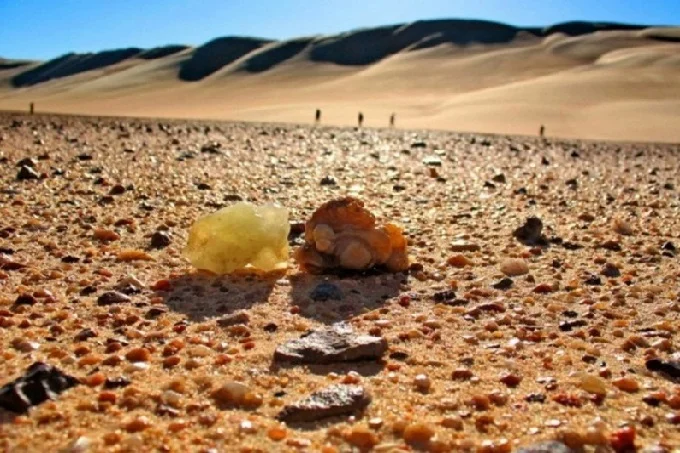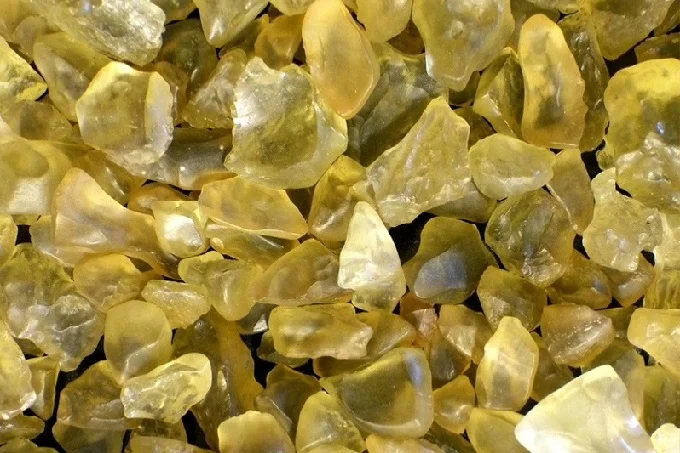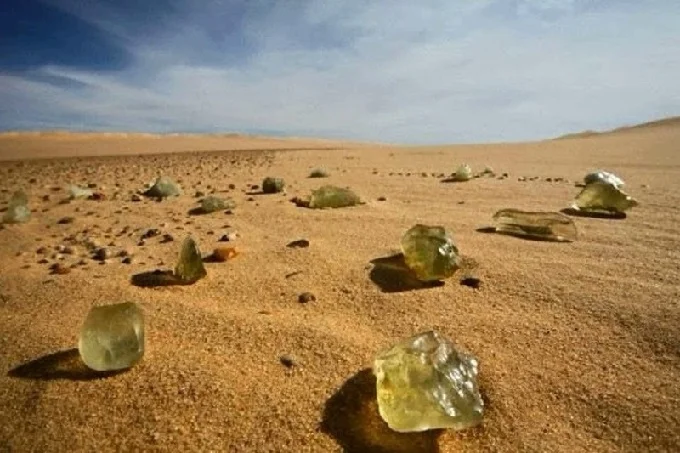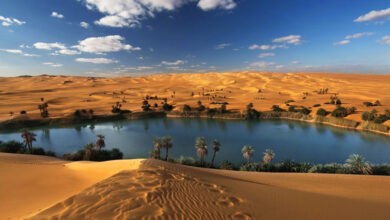Libyan desert glass: The mystery of the origin

The Libyan desert, located in the center of North Africa (to the left of Egypt) is part of the Sahara and looks like the most ordinary desert: sand, rare oases, and again sand, sand, sand. But only here, among the dunes that are tedious for a traveler, you can find a very strange substance that scientists have called Libyan desert glass.
A bottle factory?
Oddly enough, in fact, it is really glass. In any case, it looks as if there was an accident at the glass factory, and the workers, instead of making lemonade bottles and other household necessities from the resulting product, were forced to simply pour the molten quartz onto the ground, where it froze as it pleased. And now it lies scattered on the sand in shapeless pieces, shining under the tropical Sun with the familiar greenish-yellow bottle color.
By the way, the version about the plant has a right to exist. After all, for a long time, the superiority in glassmaking was attributed to neighboring Egypt. For example, the glass-glazed faience tiles of the internal facings of the pyramid of Josser date back to the XXVII century BC. That is, the Egyptians were able to produce glass five thousand years ago. Why shouldn’t a profile plant exist? To get the latest stories, install our app here.
And here’s why. It’s not even that it’s hard to imagine a modern large enterprise in the middle of a hungry desert. Moreover, there used to be quite a blooming region here. And the thing is that Libyan glass is not five thousand years old, and not even 50 thousand, but a hundred!
The atomic bomb
So, who could a hundred thousand years ago carelessly “spill” hundreds of tons of molten quartz on the territory of Libya on an area of about 150 by 30 kilometers? No one – scientists answer.

In any case, the cataclysm really happened here. But not production, but rather military-space. It’s just that something so powerful exploded over the sand dunes that melted the sand and turned it into a glass.
As in the state of New Mexico, after the test of the American atomic bomb there, or as in Kazakhstan, at the Semipalatinsk test site, after the test of the Soviet atomic bomb there. The picture is the same everywhere: the sand surrounding the epicenter of the explosion necessarily turns into glass. To get the latest stories, install our app here.
Do you notice where they are going? It turns out that a hundred thousand years ago, an atomic war took place on the African continent, or whatever it was then! Moreover, it walked not only through Libya, but also hooked the Sinai Peninsula, where stones melted by ultra-high temperatures were found.
Attack from outer space
Other scientists (and there are a lot of scientists now) claim that everything was almost like that, but not quite. Yes, they say, there were explosions, there were high temperatures, sand was melting. However, it is not atomic bombs that are to blame for this cataclysm, but guests from outer space – meteor showers that attacked the desert, exploded over it, and turned quartz into a glass.
Well, the first scientists, supporters of the atomic bombing, answer them. Then where are the craters from these meteor showers? Where, in fact, are the remnants of the meteorites themselves? Surely they couldn’t all have blown up without leaving any trace?
And then, Dr. Farouk El-Baz and colleagues from Boston University very timely discover a crater with a diameter of 31 kilometers just on the border of Libya and Egypt. It seemed that this was the answer to the question. Therefore, the “bombardment” of meteorites is to blame for everything.
No, the “atomists” object. Firstly, the Kebiru crater (as it was called) was formed tens of millions of years ago, that is, an order of magnitude earlier than the birth of Libyan glass. And secondly, it is located a hundred kilometers from the places where this glass is found. Besides, if we follow the statement that meteorites are to blame for the origin of glass, then why can they be found only in a limited area? Or did the meteorites diligently avoid all the other sand-covered areas of the planet? To get the latest stories, install our app here.
New discoveries
The investigation has reached an impasse. “Atomists” and supporters of the “meteorite” theory amicably went to the dunes in search of evidence of their claims, and they found something.
Firstly, it turned out that the Libyan glass found in the same places can be thousands or hundreds of thousands of years old. That is, it did not appear simultaneously, but as a result of periodic effects of high temperatures with a spread of millennia. Secondly, the French researcher Philippe Pelloux in 2003 discovered a whole hundred craters covering the surface of more than five thousand kilometers in the Sahara. The study of the craters showed that they just appeared literally at the same time as a result of the most massive meteorite bombardment in the history of our planet. However, this cataclysm happened 50 million years ago. In addition, a thorough study of the chemical composition of the glass itself revealed traces of meteoritic components in it.
It seemed that all three discoveries poured water on the mill of supporters of the meteorite theory. Here you have craters, meteorite particles in the glass, and a spread in time – someone could not drop atomic bombs on the Libyan desert to bomb with such an enviable regularity.

But the “atomists” are no strangers to this, either. They explained the difference in the age of the pieces of Libyan desert glass by the effect of the radiation itself, which simply “aged” its different pieces in different ways. The microscopic content of meteoritic elements – and where there are none? The Earth has been “bombarded” from space for more than a million years, so these elements are found almost everywhere.
As for the craters – if they were smaller, but in the center of the “glass” territory, then – yes, the argument. But as it turns out, there are craters and many of them, but all of them are somewhere aside, and in the same area (recall: 150 by 30 kilometers) where only the Libyan glass occurs, no craters were found. To get the latest stories, install our app here.
Deadly Rays of Urey
When science is powerless, it remains to turn to myths. So, the most famous myth, born in Thebes (as the Greeks called the capital of Upper Egypt) tells us the following.
Once upon a time, the god Ra created the world and the people. The world was a better place than it is now, but the people, judging from what happened next, were not much different from us. Ra ruled over them until he was old, probably wisely and justly, but when he became quite frail the people rebelled and decided to overthrow their ruler. They gathered an army and stormed the palace.
But it was not that easy. Ra, who was old and not yet senile, cracked the plot before the rebels got to his home. He gathered the other gods together and asked them for advice: should he destroy the rebels? The other gods answered that there was nothing to think about. So Ra climbed the wall and directed his Eye-Sun at the army of men, from which the sizzling rays of Ureus (that’s it!) came.
The Egyptians so call the cobra-shaped solar eye, which is often present on the headdresses of pharaohs. Apparently, this fashion came from Ra.
It would seem that this is the end of the fairy tale. The eye of the Sun burned away the sand where an army of men stood, turning it into a glass, as it seemed to the blind Ra. But – all past it! The people took advantage of this blunder, divided into small detachments, and hid behind rocks…
Here we will end the story. We were only interested in the eye of the Sun that led to the formation of Libyan desert glass. And as for the people, the gods still defeated them, but in another, no less bloody way. And the sand of the Libyan desert turned into glass remained where Ra gave the rebels their first, and not the most successful, battle. To get the latest stories, install our app here.




